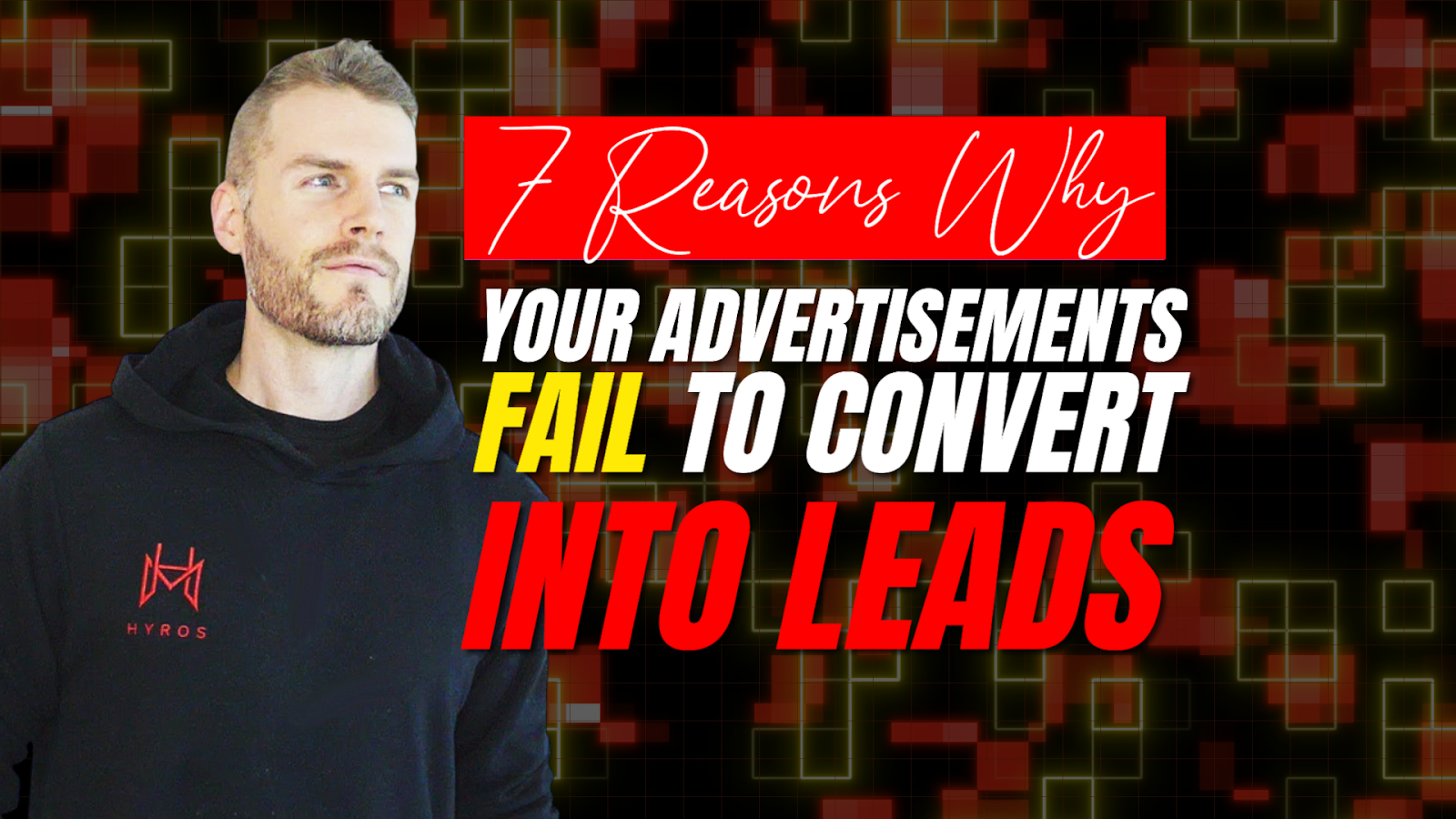
7 Reasons Why Your Advertisements Fail to Convert Into Leads
Are you among many marketers struggling to turn your online advertising efforts into tangible leads? It can be frustrating when your campaigns don’t pay off, but not knowing why is even more disheartening. Don’t give up yet – there are plenty of reasons why your ads may fail to convert, and understanding them can help you turn your campaigns around.
Failing to reach a conversion goal is often the result of advertisements that don’t effectively do their job. Whether it’s targeting the wrong audience, not providing enough value, or simply having an unappealing ad design, a variety of factors can prevent your ads from doing the one thing they need to do: convert.
So, what should you do to turn those conversions around? In this post, we’ll explore seven reasons why your ads may be failing to reach a conversion goal and what steps you can take to improve their performance. By implementing these changes, you’ll be able to optimize your ad campaigns and start seeing the results you desire. Ready? Let’s dive in.
#1: You’re Targeting the Wrong Audience

Understanding your target audience is essential for effective advertising. If you’re not targeting the right people, your ads will never reach the right people, and you won’t make any conversions. For example, if you’re selling a product or service relevant only to people in their twenties, there’s no need to advertise it to those over fifty. Failing to optimize ads based on demographics such as gender, location, and interests can lead to wasted ad spend that isn’t reaching the right people.
The same goes for audience segmentation. If you’re advertising a product or service that may be valuable to some groups but not others, it’s essential to focus your efforts on only those who are likely to convert. Overlooking critical segments of your target audience will inevitably result in fewer leads and conversions.
Finally, not understanding the needs of your target audience can prevent you from providing the right message. If you don’t know what people are looking for or why your product or service is useful to them, it’s likely that they won’t be interested in what you have to offer. Not having a clear understanding of your target audience can be detrimental to the success of your ad campaigns.
Tips for Proper Audience Targeting
- Define your target audience – what age group, gender, interests, and more.
- Use segmentation to reach potential customers better.
- Research the needs of your target audience and use this information to craft ads that are tailored to them
- Leverage marketing automation tools to optimize your campaigns based on audience data.
#2: Your Ads are Not Eye-Catching
If your ads don’t grab attention and stand out from the competition, they won’t be successful. Without something interesting to draw the eye, people will quickly move on to something else. People are constantly bombarded with ads, and if yours isn’t captivating enough to stop them, you’re missing out on potential leads.

Design is a major component of creating an eye-catching ad. Your ads lacking bold colors, exciting visuals, and an overall attractive look means they will fail to stand out. The unfortunate reality is that people are more likely to pay attention to something that looks good than something that doesn’t.
Additionally, the content of your ad needs to be engaging and relevant. People need to know what they’re going to get out of it to take the time to click and learn more. If your ad isn’t exciting or informative enough, they will ignore it, and you won’t see a return on your investment in terms of leads.
Tips for Creating Visually Appealing Ads
- Use bold colors, interesting visuals, and attractive design in your ad.
- Create content that is engaging and relevant to your target audience.
- Leverage video and other interactive content to create ads that are more likely to capture attention.
#3: Your Ads Don’t Have a Clear Call-to-Action
Picture your customer scrolling through the web, seeing an ad with a clear call-to-action, and then taking the necessary steps to make a purchase or get more information. It is a dream come true for any advertiser. Calls-to-action provide a sense of urgency and encourage customers to act quickly and without hesitation.
However, a lack of a clear call-to-action can be detrimental to the success of your ads campaign. Here are three ways in which a lack of call-to-action can make your advertisements fail to convert into leads.
Missed Opportunities
Customers are left with no direction on what to do next. This means they won’t be encouraged to take any particular action, and you could miss out on potential leads and sales.
Lack of Engagement
People may simply view your ad as an interesting piece of content without any further action, as there is no call-to-action prompting them to do anything. This can lead to a lack of engagement and further deter customers from taking any action.
Poor Timing

A sense of urgency is critical in driving conversions. Without a sense of urgency, customers are likely to procrastinate and forget about the ad altogether. This can lead to potential leads being lost as the customer doesn’t have the motivation to take any action.
Tips for Crafting Effective Calls-to-Action
- Keep it short and to the point.
- Use action words such as “buy”, “download”, or “learn more”. This encourages customers to take the next step and take action.
- Avoid being too generic. Your calls-to-action should be tailored to your specific product or service.
#4: Your Ads are Too Complicated
Creating an ad that is too complicated can be a real deterrent to potential customers. When people are bombarded with too much information all at once, they become overwhelmed and tend to lose interest in the advertised product or service. Overly complex ads can also be challenging to understand, which may cause people to move on rather than take the time to try and decipher what is being offered.
Plus, when ads are too complicated, customers are more likely to miss key pieces of information. This could mean they don’t understand what you’re offering clearly and miss out on potential leads. Simplicity can be key in creating compelling ads that convert into leads.
Tips for Crafting Simple Ads
- Be concise and only include the essential information.
- Use visuals to break up text and make the ad easier to comprehend.
- Focus on a single message or offer at a time.
- Eliminate unnecessary words or phrases that can confuse customers.
#5: Your Ads Don’t Offer Enough Value

Ads that don’t offer customers anything of value are unlikely to convert into leads. People are looking for something that will benefit them, so it’s essential to show how your product or service can do just that. Offering value through discounts, special offers, and unique features can be a great way to attract potential customers and increase conversion rates.
For example, offering limited-time discounts to customers shows them the value they are getting from your product or service. Similarly, offering unique features such as free shipping or a money-back guarantee can attract potential leads.
A marketing campaign that highlights the value of your product or service can be an excellent way to increase conversions. You want to show potential customers they are getting something special and unique when they purchase from you. Be sure to explain why your product or service is the best choice for them and how it can benefit them in tangible ways.
Tips for Offering Value in Your Ads
- Advertise exclusive deals and free offers that incentivize customers to purchase from you.
- Highlight any unique features or services that your product or service offers, as this will show potential customers the value of your offering.
- Show how your product or service differs from others on the market and explain why it’s better for them in concrete terms.
#6: Your Landing Page is Not Optimized
Your landing page is the first thing potential customers see when they click on your ad. A poorly designed or confusing landing page can be a major deterrent to potential leads and could cause them to abandon the page before even viewing your product or service.
When customers arrive at a confusing or challenging-to-navigate page, their bounce rate may increase significantly, making them less likely to convert into leads.
Alignment between landing pages and advertisements is also essential. If the two don’t match, customers may become confused and not understand what they’re being offered. You want to ensure potential customers know exactly what they are getting when they arrive at your landing page.
Tips for Optimizing Your Landing Page
Here are some tips to help you optimize your landing page and improve conversions:
Keep Your Landing Page Simple
Avoid using too many words or visuals on your landing page, as this can be overwhelming for customers. Instead, keep the design simple and focus on critical elements to help potential customers understand your offering.
Use Clear Call to Actions
Ensure your calls to action are clear and easily visible on the landing page. Use words or phrases that are easily understood and encourage customers to take action.
Match Ads and Landing Page
Your customer journey should flow seamlessly from your advertisements to the landing page. Ensure that the language and visuals used on both match so customers understand what they are being offered when they arrive on the page.
#7: Your Ad Campaign is Not Measured or Adjusted
It’s important to measure and adjust your ad campaign based on its performance. Without regular data analysis, you may be targeting the wrong audience or using ineffective tactics not resonating with potential customers. Common reasons for poor performance include not fully understanding your ideal customer or not having an average conversion rate in mind. Without this knowledge, it can be difficult to pinpoint what’s working and what isn’t.
Another common reason for failure is not making adjustments and testing different strategies. Even if your ad campaign is performing, there may be areas of improvement that can help you convert even more leads. Without measuring and adjusting your campaign performance regularly, you won’t be able to identify any such opportunities.
Tips for Measuring and Adjusting Your Ad Campaign
- Review your data regularly to identify trends or areas of improvement.
- Analyze the performance of different ad types and channels to understand the most effective ones.
- Constantly test new strategies and tactics to determine what works best for your target audience.
- Monitor customer feedback to know how people respond to your ads and adjust accordingly.
Optimize Your Ad Campaigns for Successful Conversions
Ad conversions can be a powerful tool for businesses of any size, helping to expand market reach, build customer loyalty, and increase sales. However, when your ads don’t convert, it can be disheartening. That’s why understanding the reasons behind failed conversions allows you to adjust and improve your advertising strategies for better results.
Many companies struggle to produce conversion-worthy ads, often due to targeting the wrong audience, having an unappealing ad design, and not providing enough value. Other reasons include a lack of a clear call-to-action, complicated advertisement designs, unoptimized landing pages, and a failure to measure or adjust campaigns.
No matter what shape your current advertising strategies are in, applying the tips discussed in this article to optimize your ad campaigns will help you find success with conversions. With a little effort and creativity, you can get your ads converting more effectively than ever before. So, get out there and start making your campaigns convert!
